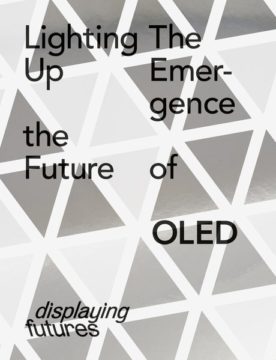Light is not always the same – and in most cases it is even more than light. This is especially true of light created using organic light-emitting diodes, known as OLEDs. The book “Lighting Up the Future – The Emergence of OLED” sees it-self as an attempt to describe this “more”, the special or unique character of OLED light.
Following a general introduction to the topic of light by way of philosophical, historical, psychological and psychophysiological observations, this “added extra” that OLED light affords is examined from the perspective of three different professions, architecture, art and product design. The Norwegian Kjetil Trædal Thorsen, co-founder of the firm of architects Snøhetta, puts forward the theory that architecture does not now have just one light source at its disposal but, thanks to OLED light, material for creating new designs and structures at the service of humankind. Willy Bucher’s OLED Box or OLED space represents OLED light in art. Among other things the Darmstadt-based artist and video artist has made a name for himself with his 3D installations. In his concept of a walk-through OLED space, Bucher applied experiences from his 3D and video installations. In traversing the box the viewer is catapulted into a completely new world of experiences, which are only made possible through the special properties of OLED light. With his “OLED Lighting Curtain” Sebastian Herkner, a young product designer from Offenbach, who has already received many prizes, international ones among them, transcends the limits of classic luminaire design and radically exploits the two-dimensional quality of OLED light in creating his lighting curtain.
Udo Heider and Jürgen Laur and their advisor Andreas Hartweg initiated and accompanied the book project. Manufacturer of OLED materials Merck sought an interdisciplinary dialog for the realization of attractive, environmentally friendly and meaningful applications. This was initially started in 2011, for the liquid crystals, with the initiative “Displaying Futures” by Roman Maisch at Merck. With their success story as an innovative component of the display industry, liquid crystals can be seen as a pioneer when it comes to interdisciplinary exchange and close partnerships with industry and research, a practice Merck has also cultivated in the field of OLED from the outset. By way of example, it was Merck that supported the first pilot designs for OLED luminaires. The result: prototypes by Ingo Maurer and Hannes Wettstein in 2006. In 2013, Merck and its project partners Audi, Philips, Automotive Lighting and Cologne University successfully installed expansive, three-dimensionally shaped OLEDs as a rear light in a car. These marked the beginnings of a highly promising technology that lends itself to a variety of applications. Taking as their motto “Merck shapes light spaces“, Heider and his team are working with partners from the relevant industries and professions on identifying the specific characteristics of OLED as a light source and making it available to those with an interest in it. Energy efficiency and sustainability play a key role in these efforts. Though theirs is a technical background, the makers of OLED at Merck are intent on not losing sight of the magic of light.
- Veröffentlicht am Dienstag 11. März 2014 von Trademark Publishing
- ISBN: 9783981586077
- 160 Seiten
- Genre: Design, Hardcover, Innenarchitektur, Kunst, Softcover
